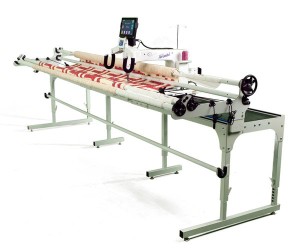There are several things that you can do in advance to get your quilt ready to be finished on a long-arm machine.
First, both the quilt and the backing should be as close as possible to square or rectangular – no trapezoids or parallelograms, please! Each corner should be 90 degrees. The top and bottom should be the same measurement, as should the right and left edges.
Second, the backing and batting must be larger than the top, framing it by 3 – 4 inches per side. They will be a total of 6” – 8” longer and wider than the top. For example, if your top measures 60” x 90”, the back and batting must be at least 66” x 96”.
Third, DO NOT pin or baste your layers together.
These three requirements will make sense when you consider how your quilt will be mounted on the long-arm machine.

The machine has two rollers in the front, and one in the back. The quilt top and bottom are attached separately to the front rollers. The backing also is attached to the back roller, and the batting and top are pinned or basted to the backing. The batting floats between the top and the back of the quilt. Clamps attached to the sides further stabilize the three layers.
There must be some clearance between the machine and the side clamps, and some fabric allowance at the top and bottom, to allow free motion from edge to edge. If the quilt (and/or the backing) is not perfectly square (and, let’s face it, many have some small variations), the quilter will need the wiggle-room afforded by the extra backing fabric to make it lay properly. (See How to Square Your Quilts for pointers on achieving even quilts.)
Please make sure your quilt tops and backs are clean and free of wrinkles and loose threads. There are surcharges for ironing and clipping threads. If you buy a wide backing, open it and examine the folds of the bolt. Those often have deep creases that require steam ironing to remove. Loose threads can create problems if the moving machine catches in them.
Finally, make sure your seams are strong. As gently as your quilt is mounted and advanced on the rollers, there is some pressure placed on the seams. This is particularly true of those seams that extend to the edges of your border. It’s a good idea to lock them with a back stitch or stay stitch the outside edge of pieced borders to avoid having the seams open. Examine the quilt for loose stitches or open seams; once the quilting has begun, repairs are much harder.
Taking the time to get your quilt in good shape before you bring it to be quilted will help us achieve peak results — and help you save money: Ironing, fixing backings, repairing seams, clipping loose threads are all subject to extra fees.

BY THE SEA CUSTOM QUILTING: 31 Vanderbilt Ave., Babylon, NY 11704; 631-804-0757